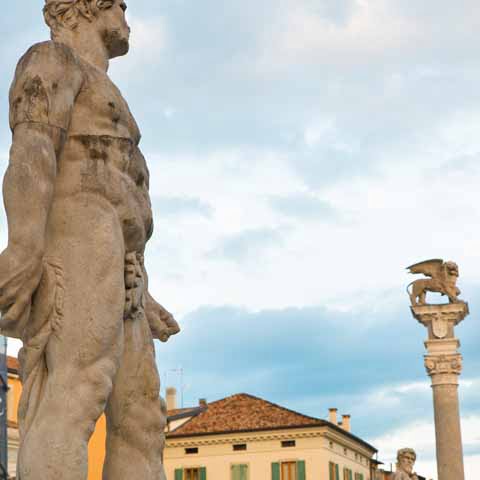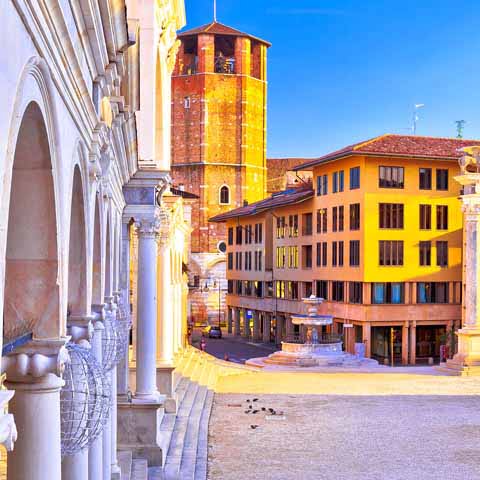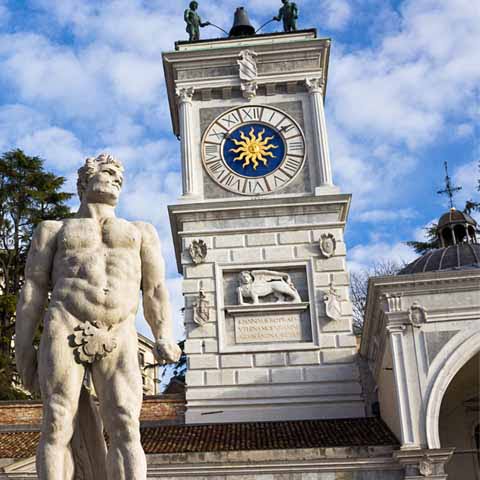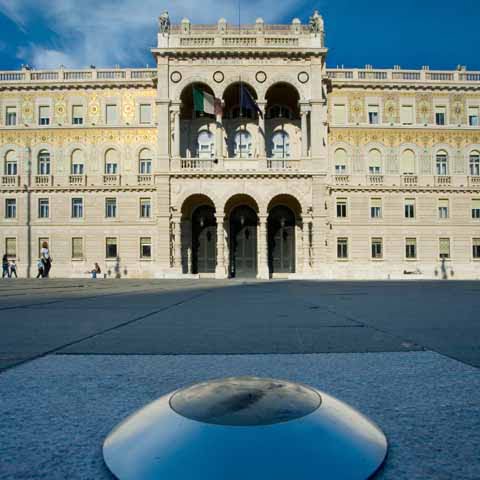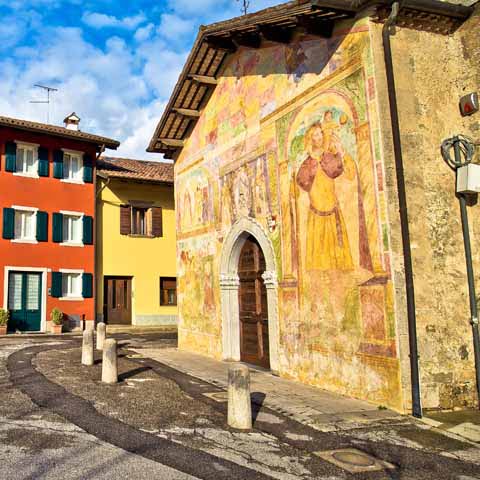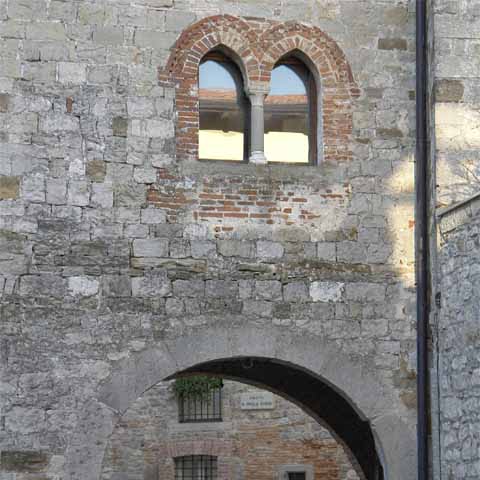Friuli Venezia Giulia – Culture
In the far corner of northeastern Italy, sits a region steeped in culture that is a beautiful blend of Austrian, Slovene, and Italian influences. Welcome to a land that whole heartedly reflects the history of its people, Friuli Venezia Giulia.
Shared European borders with Austria and Slovenia, along with a rich history of foreign and middle age influences make Friuli Venezia Giulia a region of culture more colorful and diverse than the wildflowers that grow in the region’s lush valleys.
Whether touring the dozens of castles and fortresses dotting the mountains and overlooking the Gulf of Trieste, taking in the fresco art masterpieces from local artists, enjoying the organ music and festivals, or simply sitting seaside at a quaint café to soak in the scenery that spurred on renowned Italian writers, let the flourishing culture of Friuli Venezia Giulia transport you to the ancient times that are a large part of the region’s identity today.
Friuli Venezia Giulia’s Architecture
Of all the architecture found in the region, the most prevalent is that of castles. Largely due to Friuli Venezia Giulia’s ancient inhabitants from the middle ages, much of the region is still canvased today in a vast array of stately castles and fortresses. Of these structures, perhaps the most well-known include Duino, Miramare, Muggia, and San Giusto.
Adjacent to the Gulf of Trieste sits Duino Castle, a majestic circa fifteenth century structure that is in the shape of a rectangle and sits upon a picturesque rocky cliff above the crystal blue gulf waters. The castle has a couple of tall towers with approximately half of the castle an ancient gray brick and the other a more modern texture that is a pale yellow in color.
This castle lives beyond history, it is celebrated in literature by a previous inhabitant, poet Rainer Maria Rilke. The poet was a guest of Princess Marie of the Czech branch of the House of Thurn und Taxis in the early 1900s. During his stay he began composing the Duino Elegies, a collection of poems that are considered to be Rilke’s best work. After he completed the collection of poems, he dedicated it to the princess. Today the castle is still owned by the Thurn und Taxis family today, and they have opened the museum and gorgeous park to the public.
Also overlooking the Gulf of Trieste is Miramare Castle, a magnificent nineteenth century piece of architecture. The castle is possibly more stunning than anything one might find in a child’s fairy tale.
The exterior of the structure is a stately gray and features one large tower with a flag. The interior of the castle is one truly fit for royalty. A tour through the castle reveals a luxuriously rich atmosphere complete with original paintings, chandeliers, dark polished furniture, and heavy red curtains. While the castle is a work of art all on its own, the castle grounds are upon a scenic cliff and area of more than fifty acres that were personally designed by the Austrian Archduke Ferdinand Maximilian. That area now includes a wide variety of tropical plants and tree species that add to the charm of the castle grounds.
Castle visitors are usually able to visit the throne room, Maximilian’s chambers, and several guest rooms.
The Castle of Muggia is in the southeastern area of the Province of Trieste. The castle was heavily marred in the mid fourteenth century but has experienced some renovations throughout the centuries.
More recently the castle was restored by owner and sculptor Villi Bossi and his wife. Seeing the castle and its historic grounds are a fantastic way to spend the day.
The San Giusto Castle of Trieste is a regal castle that although built for it, never experienced direct military activity. The circa fourteenth century structure overlooks the Gulf of Trieste in the distance.
The exterior of the castle is somewhat standard, but inside visitors will find a museum. The museum showcases a collection of historical weapons dating back to the twelfth century, including swords, armor, guns, daggers, and more. Visitors might also enjoy seeing Venetian style furnishings and a canvas painting by artist Andrea Celesti.
One of the more modern monuments in Friuli Venezia Giulia is the Faro della Vittoria. The popular structure is a lighthouse located on the hill of Gretta that faces the Gulf of Trieste. The lighthouse is over two hundred feet tall, making it one of the tallest structures of its kind in the world. It is dedicated to those who lost their lives in World War I.
An architectural feat that can be best appreciated by air is Palmanova, a city in southeastern Friuli Venezia Giulia. The city is in the shape of a nine point star that is built within a larger nine point star.
The fortress is a bastion style common in the late Renaissance period. This particular shape lent itself to protection against enemies and is a stunning piece of defensive engineering.
Art
When visiting the Udine castle, architecture is just part of the overall art experience. This grand castle is built on a hill at the heart of Udine and stands tall above a well-manicured green lawn. The real surprise is inside where an Udine history and art museum resides. Visitors may enjoy an assortment of intricate drawings and prints, classic photography, and even an ancient art gallery with some precious ancient paintings.
The Palazzo Ricchieri is located in Pordenone. The palace is home to the Civic Museum of Art which showcases a fine collection of period paintings and wooden sculptures. Perhaps one of the most breathtaking pieces of art inside is the main hall which is frescoed, or painted on fresh plaster, with the
Story of Tristan and Isolde from the fourteenth century.
Also located in Pordenone is the small town of Spilimbergo. The city is home to what is referred to by locals as the Mosaic School of Friuli. The town is often known as the city of mosaics because of its production of creative wall mosaics and decorative pavement.
The fresco works of Giovanni Battista Tiepolo, a renowned Italian painter of the turn of the eighteenth century are on display in several places in Friuli Venezia Giulia. The Archbishop of Udine hired Tiepolo to embellish the chapel in the cathedral of Udine. Tiepolo’s work was so outstanding, the archbishop also asked him to paint other scenes at his palace that depict Abraham and his descendants mentioned in the book of Genesis. These early paintings of Tiepolo are considered some of his finest works.
Literature in Friuli Venezia Giulia
Trieste is a city that is in many ways made for aspiring writers. With little cafes lining the streets that offer a glimpse of the sparkling blue Gulf of Trieste, it is no surprise that literature has flourished and continues to do so in Friuli Venezia Giulia.
Italian poet and writer, Umberto Saba, was born in Trieste in the late nineteenth century. While writing, Saba became the owner of an antique bookstore in the city in the early twentieth century. He self-published Songbook, a collection of poems that grew over time to include more than four hundred poems that he wrote over several decades. Saba routinely struggled with depression, but did not let it hinder him from producing beautiful literary works.
Aron Ettore Schmitz, sometimes referred to as Italo Svevo, was a popular Italian writer that also dabbled in play writing and business. His classic work La Coscienza di Zeno is considered to have had a profound effect on the modernist movement. This early twentieth century writer is thought to be the pioneer of the Italian psychological novel.
Italian writer and scholar Claudio Magris’s most important work to date is thought to be Danubio. The novel tracks the Danube River from its source all the way to the sea. The tracing of the Danube is a colorful tale filled with touches of European history. Magris at one point taught modern German literature at the University of Trieste.
Music in Friuli Venezia Giulia
As with most of the culture, the Austrian and Slovene influences have also shaped Friuli Venezia Giulia’s music. One of the more popular instruments in the area is the organ. The Province of Pordenone hosts an annual international organ festival that was established to pay homage to the Renaissance organ.
A number of theaters and auditoriums are sprinkled throughout the region. Perhaps one of the most prominent musical theaters in the region is Teatro Giuseppe Verdi in Trieste. Also in Trieste is the Giuseppe Tartini music conservatory which hosts the internally renowned Trieste Trio chamber music ensemble. The province of Gorizia boasts at least half a dozen auditoriums that host various musical events during the year, one of which is the international Rudolfo Lipizer violin competition.
Furlana is said to be named from Friuli Venezia Giulia. The dance, known as a courtship dance, was largely popular in Venice before spreading throughout Europe. It is said that this dance may have inspired prominent composers such as Bach, Ravel, and Rameau.
To take in the culture of Friuli Venezia Giulia is to also see a small piece of Austrian and Slovene culture.
This blend is part of what makes the region so unique in the customs and traditions. Immerse yourself in the culture and revel in all that Friuli Venezia Giulia has to offer.
Travel Guides


